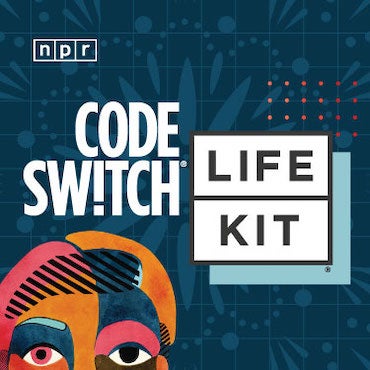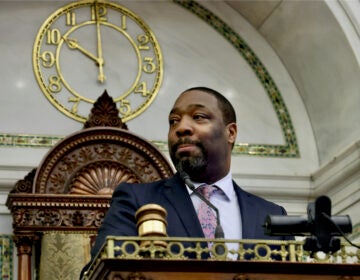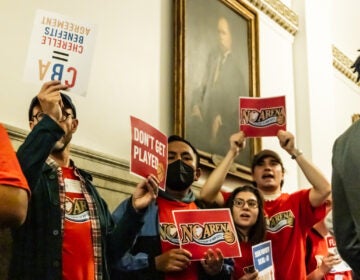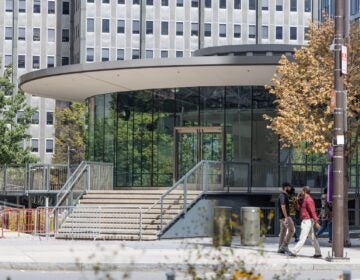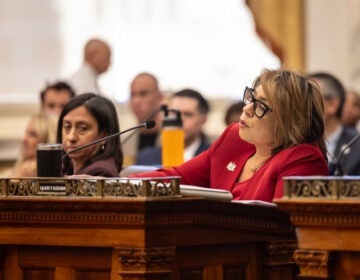Philly City Council kicks off series of hearings devoted to Sixers’ arena proposal
For more than four hours, lawmakers questioned Parker administration officials about the agreement reached with the team, transportation to the arena and community benefits.
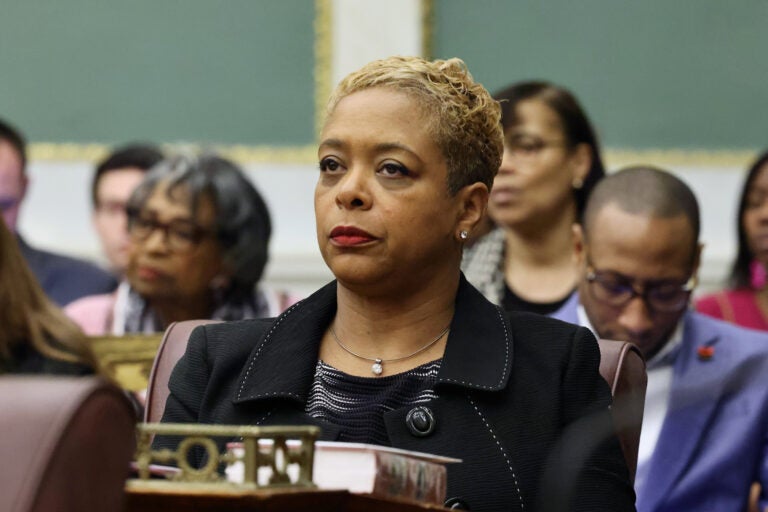
Philadelphia City Councilmember Cindy Bass. (Emma Lee/WHYY)
What you need to know
- The 76ers have proposed moving to a new $1.55 billion arena near Chinatown called “76 Place”
- The proposal has drawn swift condemnation, excitement, skepticism — and plenty of buzz
- Black Clergy of Philadelphia has endorsed the project, while a majority of Chinatown businesses and other community members have voiced their opposition
- Philly Mayor Cherelle Parker formally announced her support for the arena and unveiled a community benefits agreement
The 76ers and SEPTA have yet to reach an agreement over how the cash-strapped authority will cover the additional operational costs it is expected to incur if the team’s $1.55 billion arena proposal is authorized by City Council.
That fact, and the need to find a financial solution, came up repeatedly Tuesday during the first in a series of daylong council hearings dedicated to examining the Sixers’ plan to build a new facility on top of Jefferson Station in Center City.
The hearing unfolded on the same day SEPTA announced its own plans to significantly raise fare prices and make severe service cuts in the face of a fiscal crisis. The authority is also in the midst of negotiating a new contract with its largest bargaining unit, which is demanding higher wages for its members, among other things.
“SEPTA is saying they’re not paying for these costs. They’re not gonna do it. And so the question is, ‘Who’s gonna do it?’” said Councilmember Cindy Bass.
While Mayor Cherelle Parker’s administration is a party to those negotiations between SEPTA and the Sixers, officials told council members there is no plan for taxpayers to contribute more money to the authority, including for upgrades to Jefferson Station during construction or to run additional trains for fans using SEPTA’s Regional Rail lines to get home from games and events.
They said Parker’s first budget already increased local funding for SEPTA, and that anything beyond that will need to be negotiated with the Sixers. Officials testified that the team has already agreed to pay for any operational costs for physical changes to the station.
“We have done our part to support SEPTA,” said Michael Carroll, deputy managing director for the Office of Transportation and Infrastructure Systems. He added that additional funding is needed to extend Regional Rail service on all days.
SEPTA and the Sixers declined to comment.
Room for negotiations?
The team is scheduled to take questions from lawmakers Wednesday. SEPTA is expected to testify next week. Other hearings will be more acutely focused on the enabling legislation the franchise needs to pass to start construction. Lawmakers will also hear from proponents and opponents before voting on the controversial project, announced more than two years ago.
The team has said it needs council to approve the arena before the end of the year for the development to remain on track. The team hopes to open the arena in 2031, the year its lease expires at the Wells Fargo Center in South Philadelphia.
During Tuesday’s hearing, council members also spent considerable time dissecting the community benefits agreement the administration negotiated as part of a broader deal with the Sixers. Parker, who did not attend the hearing, has called the deal “historic” and “the best financial deal ever” for a Philadelphia sports arena — a development she says will generate millions in new tax revenue, create hundreds of jobs and help revitalize Market East.
The CBA is a centerpiece of the agreement. The legally binding document includes $50 million for an array of citywide initiatives and programs, as well as efforts designed to mitigate concerns raised by neighborhoods that will be directly impacted by the arena, including Chinatown and Washington Square West.
Lawmakers pressed the administration on whether the terms of the CBA — the content and dollar amount — were negotiable now that it was up for consideration in Council. Community stakeholders did not have a seat at the table while the agreement was being fashioned.
“Is there any appetite from the admin to renegotiate some of these things to put us in a position to be able to find something that is a little more beneficial to the city of Philadelphia than what we have in place right now?” said Councilmember Isaiah Thomas.
“We stand by the CBA that we introduced,” said Tiffany Thurman, Parker’s chief of staff. She later added that “we respect the process.”
Council members may seek more funding to support nearby communities, particularly Chinatown, where residents and business owners say the arena poses an existential threat to the neighborhood.
At the moment, about half of the funding will go to nearby communities. That includes $1.6 million for a business disruption fund, which will provide grants to help small businesses during the construction of the arena, which would start in 2028 after a third of the Fashion District mall is demolished.
Echoing some of her colleagues, Bass called the amount inadequate to “keep businesses afloat.” And she urged the administration to include more dedicated funding in the CBA.
“Let’s not start out shorting businesses that need these funds,” said Bass.
The current total is partially a reflection of the fact that streets are not expected to close while the arena is constructed, said Sophie Bryan, chief policy officer for the administration. She added that the total is meant to support about 40 businesses that sit closest to the proposed site.
The administration also pointed to the $14 million that will go toward funding an arena special services district, saying that some of that funding may be used to further help businesses negatively impacted by the arena’s construction.
“Mayor Parker is committed to ensuring Chinatown’s continued vitality and position as a treasured cultural community for long-term residents, new residents and visitors from near and far,” said Thurman.
A focus on workforce diversity
Lawmakers also had a number of questions about the implementation and oversight of the administration’s economic opportunity plan for the arena, which is centered around workforce diversity and giving minorities, women and disabled people the chance to benefit from the arena during construction and once the facility opens.
The EOP will have an oversight committee that will be required to track and report on the progress being made on a variety of related goals. Officials assured council members that the plan would not pit one racial group against another, and that it would be a model for the city moving forward — not just a one-off deal for the arena.
“We are confident that this EOP will deliver results with its focus on both the numeric participation goals it sets and the terms and conditions it includes to enable the city to track and enforce compliance across the construction period and during the arena’s ongoing operation,” said City Solicitor Renee Garcia.
The hearings get underway as arena opponents continue to fight to defeat the development, which they argue will dismantle Chinatown, particularly the hundreds of small businesses in the area. Critics argue those businesses, and others near the arena, will be hurt by traffic congestion created by games and events, as well as competition from arena vendors.
Before the hearing got underway, dozens of people gathered outside City Hall to voice their concerns about the project during an informal hearing set up outside the building.
That includes concerns about traffic impeding ambulances making their way to the emergency room at nearby Jefferson Hospital, an issue administration maintained on Tuesday will not be a problem.
“Health care is one of the most vital services in our community, yet the proposed arena threatens to jeopardize access for thousands of Philadelphians. It’s unthinkable that the city is considering a project that would do so much to harm a patients’ ability to reach critical care in an emergency,” said Olivia Gong, a medical student in the city.
The hearings are scheduled to wrap up Dec. 3.
Council will then vote on the administration’s legislative package, which consists of 11 bills and two resolutions. It contains bills related to zoning and planning, as well as measures related to an existing neighborhood improvement district and financial arrangements tied to the Fashion District mall.
They will also consider two bills introduced by Councilmember Mark Squilla, whose district includes the proposed site. One would create a special services district around the arena, a measure designed to give nearby residents some agency when it comes to the conduct of the arena. The other would create a new zoning overlay for Chinatown, in part to preserve the scale of the neighborhood.
During last week’s session, five lawmakers voted against a pair of procedural resolutions connected to the legislative package authorizing the arena. That group would need to grow to nine for the arena not to move forward.
On Tuesday, detractors argued that City Council should not be devoting so much time to a project that is widely disliked by residents, especially while the city is faced with more pressing issues, including the potential closure of more of its public schools.
“Is this really our top priority right now?” said Councilmember Kendra Brooks.

Subscribe to PlanPhilly
WHYY is your source for fact-based, in-depth journalism and information. As a nonprofit organization, we rely on financial support from readers like you. Please give today.
